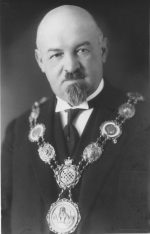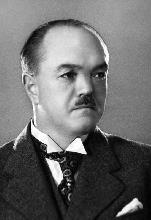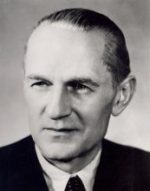The history of the establishment and development of the Institute of Concrete and Masonry Structures was significantly influenced by the development of the organisational structure of the whole school. The Institute in its present form has not always been an independent part of the School or Faculty of Civil Engineering. Its size and focus were influenced by the traditional division of civil engineering into civil and structural engineering and also by the division into bridges and other structures.
In 1903, the Institute of Bridge Engineering was established in field of study of Civil Engineering under the leadership of Prof. Dr.techn. Adolf Štys, which was focused on teaching bridges made of various materials. The scope of teaching of this institute was significantly influenced in 1910 by the establishment of the Institute of Concrete Construction under the leadership of prof. Ing. Josef Rieger.
In 1937, the Institute of Reinforced Concrete was established in study programme of Architecture and Building Constructions and the Institute of Special Steel and Concrete Structures in study programme of Civil Engineering, which later merged with the Institute of Concrete Construction under prof. Ing. Dr.techn. Konrád Hruban. This institute did not include the construction of concrete bridges, which were part of the Institute of Concrete Bridges and Construction Mechanics – headed by prof. Ing. Dr. Ladislav Záruba.
In 1950-1951, after the establishment of the Faculty of Civil Engineering (FIS) and the Faculty of Architecture and Building Constructions (FAPS), the Department of Concrete Construction was established at FIS again under the leadership of prof. Ing. Dr. tech. Konrád Hruban, DrSc. At FAPS at that time, the Department of Statics of Building Structures was established, providing also the teaching of concrete construction subjects.
In 1954, the Department of Concrete Bridges and Structures was established at FIS after the integration of the Concrete Bridges Branch, the head of which became prof. Ing. Dr. Ladislav Záruba, DrSc. At FAPS, the teaching of concrete construction was provided by the Department of Mechanics and Structures of Civil Engineering under the leadership of prof. Ing. Dr. Alois Král.
After the creation of the joint Faculty of Civil Engineering (FAST) in 1960, the joint Department of Concrete Structures and Bridges was created by merging the former departments at FIS and FAPS, where the heads were prof. Ing. Mojmír Cigánek, DrSc., prof. Ing. Adolf Fiala, CSc. and doc. Ing. Milan Procházka, CSc.
After 1990 the department was renamed the Institute of Concrete and Masonry Structures. Its heads were successively prof. Ing. Dr. Zdeněk Šmerda, CSc., prof. Ing. Jiří Bradáč, CSc., prof. Ing. Jiří Stráský, DSc. RNDr. Ing. Petr Štěpánek, CSc. dr.h.c. Currently, the head of the institute is doc. Ing. Miloš Zich, Ph.D.
Important personalities
 During the history of the Institute, a number of important personalities have contributed to its activities. The founder of the Institute, prof. Ing. Josef Rieger (1880-1941) worked at the Czech Technical University from 1903 to 1940. He became famous for his special logarithmic ruler and many works on elasticity and strength with regard to concrete stiffening and the solution of many statically indeterminate structures. In 1932-1933 he held the rector’s office of the then Czech Technical University in Brno.
During the history of the Institute, a number of important personalities have contributed to its activities. The founder of the Institute, prof. Ing. Josef Rieger (1880-1941) worked at the Czech Technical University from 1903 to 1940. He became famous for his special logarithmic ruler and many works on elasticity and strength with regard to concrete stiffening and the solution of many statically indeterminate structures. In 1932-1933 he held the rector’s office of the then Czech Technical University in Brno.
Among the well-known personalities we can include prof. Ing. Dr.tech. Konrad Hruban, DrSc., Dr.h.c. (1893 – 1977), who worked at our school from 1937 to 1953. He focused his activities mainly on reinforced concrete structures and the theory of their design. His works on shell structures are important. He also pioneered the dimensioning of reinforced concrete elements and structures by the degree of safety method. Recently, the faculty awarded an annual prize to the best thesis, which bore his name.
 Prof. Ing. Dr. Ladislav Záruba, DrSc. (1886-1963) worked at the school from 1911 to 1958. He successfully combined his theoretical work with practical and design activities. He was the author or co-author of many reinforced concrete structures built in Moravia. Among his works are especially well-known works focused on the design of bridge arches and vaults and plan curved continuous beams.
Prof. Ing. Dr. Ladislav Záruba, DrSc. (1886-1963) worked at the school from 1911 to 1958. He successfully combined his theoretical work with practical and design activities. He was the author or co-author of many reinforced concrete structures built in Moravia. Among his works are especially well-known works focused on the design of bridge arches and vaults and plan curved continuous beams.
Prof. Ing. Mojmír Cigánek, DrSc. (1906-1976), who worked at the Institute from 1954 to 1974, laid the foundation for the direction of experimental research on real concrete structures. He achieved success in the field of analysing the causes of failures of concrete and masonry structures and their subsequent progressive and unique reconstruction.
A significant figure in the history of our bridge construction was prof. Ing. Karel Zůda, DrSc. (1910-1991), the head of the Department of Concrete Bridges, who worked at the Institute from 1957 to 1975. In his activities he focused mainly on the development of bridge structures made of prestressed concrete. At that time, one of the important experts in the field of prestressed concrete was Assoc. Ing. Zdeněk Kaucký, CSc. (1931-1982), who contributed to the development of the theory and practice of precast prestressed concrete structures and bridges during his tenure at the institute from 1960 to 1975.
Other important personalities include prof. Ing. Dr. Zdeněk Šmerda, CSc. (born 1922), who worked at the Institute from 1948 to 1970 and from 1990 to 1992 (as Head of the Institute). In his work he focused mainly on spatial concrete structures, shells, tanks and storage tanks, prestressed concrete, volumetric changes in concrete and lightweight structural concrete.
Among the prominent personalities are Assoc. Ing. Zdeněk Bažant, CSc., who focuses mainly on flat, prefabricated and civil engineering reinforced concrete structures, on the reconstruction of reinforced concrete and masonry structures of civil engineering buildings (especially with the use of prestressing) and on the diagnosis of failures of reinforced concrete and masonry structures of civil engineering buildings









